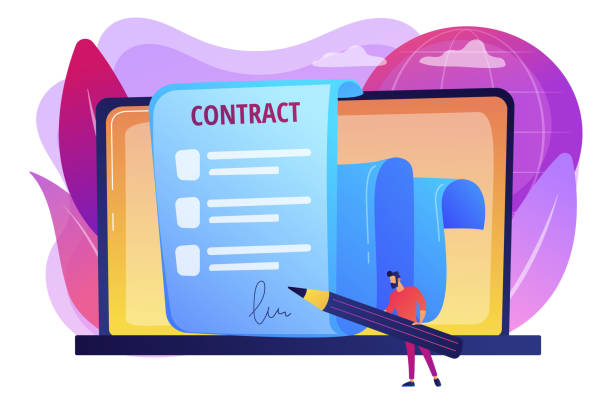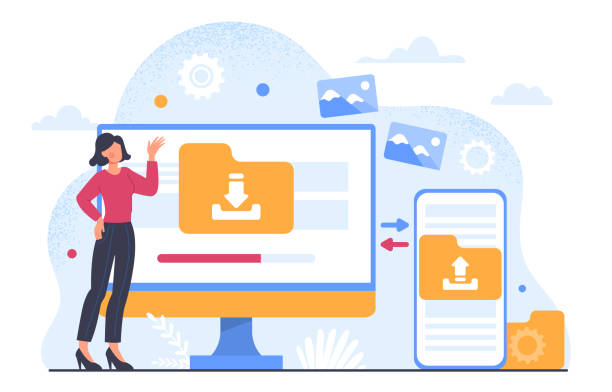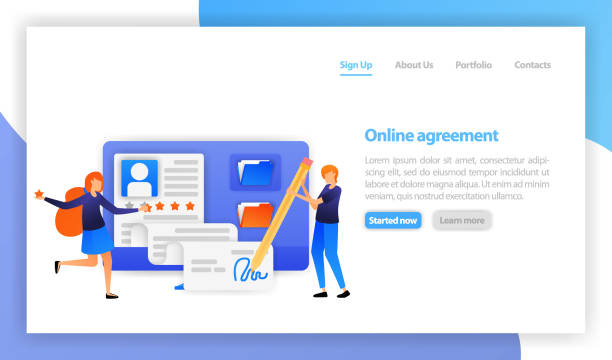Introduction to SEO-Optimized Website Design and Its Importance

In today’s digital world, merely having a website is not enough.
To be seen and attract target audiences, your website must be optimized for search engines.
This is where the concept of SEO-optimized website design becomes important.
SEO (Search Engine Optimization) is a set of techniques and strategies that helps improve your website’s ranking in search results.
However, SEO-optimized website design is carried out from the very beginning with the goal of achieving these top rankings.
This approach means structuring the website in a way that is understandable and accessible to both users and search engine robots.
#Organic_traffic, #online_visibility, and #brand_credibility are among the most important advantages of this type of design.
A website properly designed for SEO can naturally attract a large volume of visitors without needing paid advertising.
This not only helps reduce marketing costs but also leads to a higher conversion rate because users are actively searching for specific information or products and find your website.
The importance of this is amplified, especially for small and medium-sized businesses with limited marketing budgets.
Ultimately, SEO-optimized website design is a long-term investment that guarantees your credibility and position in the online space and provides a strong platform for future growth and development.
It is a comprehensive approach that covers everything from information architecture to content creation and technical aspects to bring you the best results.
Did you know that your company’s website is the first point of contact for 75% of potential customers?
Your website is the face of your brand. With **Rasawab**’s corporate website design services, build an online presence that earns customer trust.
✅ Create a professional and lasting image for your brand
✅ Attract target customers and increase online credibility
⚡ Get a free consultation from **Rasawab**’s experts!
Key Pillars of Successful SEO-Optimized Website Design

To achieve an SEO-optimized website design that yields real and sustainable results, special attention must be paid to several fundamental pillars.
The first and perhaps most important pillar is Technical SEO.
This includes site loading speed, mobile-friendliness, proper URL structure, the use of XML sitemaps and robots.txt files, and the implementation of SSL certificates for website security.
A slow or mobile-inaccessible website severely harms its SEO ranking.
The second pillar is content quality and its optimization for target keywords.
Website content must be specialized, original, practical, and engaging to both satisfy users and help search engines understand your website’s topic.
Question-provoking and comprehensive content can increase user engagement.
Proper use of headings, meta tags, and meta descriptions are also vital components of this section.
The third pillar is User Experience (UX).
Search engines are increasingly prioritizing user experience signals such as Bounce Rate, Dwell Time, and ease of navigation.
A website with an attractive visual design, easy navigation, and organized content provides a positive user experience, which in turn helps improve SEO.
SEO-optimized website design also requires a strong link-building strategy.
Quality backlinks from reputable websites increase your domain authority and signal to search engines that your website is a reliable and valuable resource.
Ultimately, SEO-optimized website design is a continuous process that requires constant monitoring, analysis, and updates to keep pace with changes in search engine algorithms and competitors.
Keyword Research: The First Step in SEO-Centric Design

Keyword research is the backbone of any successful SEO-optimized website design strategy and can be considered the first and crucial step in this process.
Without understanding what phrases your target audience uses to search for products, services, or information, website optimization would be virtually useless.
This process involves identifying words and phrases that users enter into search engines and that are relevant to your business or website content.
The goal is not just to find keywords with high search volume, but to find words that accurately reflect the user’s intent and increase the likelihood of converting them into customers or loyal visitors.
For example, a user searching for “buy laptop” has a purchasing intent, while someone searching for “best laptops of the year” is looking for information and guidance.
For keyword research, various tools such as Google Keyword Planner, Ahrefs, SEMrush, and KWFinder are available to help you identify search volume, competition level, and related keywords.
Paying attention to Long-tail Keywords, which consist of three or more words, is also very important.
These keywords usually have lower search volume but higher conversion rates because they are very specific and targeted.
An SEO-optimized website design strategically uses these keywords in content, titles, and meta descriptions to attract highly targeted traffic.
Keyword research is a tutorial and continuous process; keywords evolve with changing trends and user search behavior.
Therefore, periodically reviewing and updating the keyword list is essential to maintain the effectiveness of your SEO strategy.
This section forms the foundation for content creation and website structure, and without it, your SEO efforts will not be on the right track.
| Keyword Type | Description | Example | Application in SEO-Optimized Design |
|---|---|---|---|
| Short-tail Keywords | Short and general phrases with high search volume and intense competition. | Laptop, phone | Typically for the homepage or main category pages. |
| Mid-tail Keywords | Slightly longer and more specific than short-tail keywords, with moderate search volume and competition. | Buy Dell laptop, best Samsung phone | For product pages, services, and general blog posts. |
| Long-tail Keywords | Very specific and long phrases with lower search volume but more precise user intent. | Review of affordable gaming laptop, how to replace iPhone 13 battery | Ideal for blog articles, guides, and FAQ pages. Have high conversion rates. |
| Latent Semantic Indexing (LSI) Keywords | Related and synonymous phrases that help search engines better understand content. | (For “laptop”): notebook, portable computer, electronic gadget | For enriching content and avoiding excessive repetition of main keywords. |
Content Optimization for Search Engines

Content is king; this statement holds especially true in the field of SEO and SEO-optimized website design.
After identifying suitable keywords, the next step is to produce and optimize content that is both valuable to users and easily understandable by search engines.
Content optimization doesn’t just mean frequently inserting keywords into the text, but rather using them naturally and intelligently in strategic positions.
The page title (Title Tag) and meta description are the first elements that users and search engines see in search results; therefore, they should be engaging, relevant, and contain primary keywords.
Using appropriate headings (H1, H2, H3…) in the content structure helps with readability and informs search engines about the topics of different content sections.
One important aspect of content optimization for SEO-optimized website design is creating deep and comprehensive content that addresses all aspects of the intended topic.
Analytical and explanatory content that answers user questions and provides complete information usually achieves a better rank.
Adding relevant images and videos, optimized with appropriate alt tags, not only improves the user experience but also provides more opportunities for ranking in image and video searches.
Internal Links also play a vital role in content SEO.
By linking from one page to other pages within your website, you help users find more relevant content and also help search engines better understand your website’s structure and transfer page authority among them.
Finally, website content should be updated regularly.
Outdated information not only does not help users but may also receive less attention from search engines.
A continuous strategy for content production and updates is essential for maintaining rankings and attracting stable traffic.
Does your current e-commerce website design lead to lost customers and sales?
Rasawab is your solution with modern and user-friendly e-commerce website designs!
✅ Significant increase in conversion rates and sales
✅ Strong branding and building customer trust
⚡ Get a free e-commerce website design consultation from Rasawab!
The Role of User Experience (UX) in SEO and Website Design

In the past, SEO focused more on technical aspects and keywords, but with the evolution of search engine algorithms, especially recent Google algorithms, User Experience (UX) has become one of the most important ranking factors.
An SEO-optimized website design today must be inextricably integrated with UX principles.
Search engines aim to provide the best possible experience to their users, and therefore, websites with poor user experience cannot achieve top rankings, even if they have excellent content.
Factors such as page loading speed, responsiveness (compatibility with various devices including mobile), easy and intuitive navigation, text readability, and visual appeal all impact user experience.
Websites that load slowly or do not display correctly on mobile will have a high bounce rate.
A high bounce rate and low dwell time on the site send negative signals to search engines, indicating that users have not had a good experience.
This issue can severely reduce your website’s SEO ranking.
An SEO-optimized website design focusing on UX means building a website where users can easily find the information they need, navigate easily, and enjoy interacting with it.
Using appropriate white space, readable fonts, clear and logical Call-to-Action buttons, and logically organizing content all contribute to improving UX.
Engaging content or interactive content can further engage users and increase their dwell time.
In other words, when users are satisfied with your website, search engines also reward it.
This synergy between UX and SEO is absolutely essential for a website’s success in search results today, and neither should be sacrificed for the other.
Technical Aspects of SEO-Optimized Website Design

In addition to content and user experience, technical aspects also play a pivotal role in SEO-optimized website design.
Without strong technical foundations, even the best content may never be properly indexed and ranked by search engines.
One of the most important technical aspects is site loading speed.
Today’s users are impatient, and if your website doesn’t load within a few seconds, they will likely leave.
Google also places great importance on site speed and considers it a ranking factor.
Image optimization, caching, and code compression are among the methods to increase site speed.
Responsive Design, meaning the website’s compatibility with various screen sizes, from desktop to tablet and mobile, is crucial.
Given the ever-increasing use of mobile for searching, Google prioritizes mobile-friendly websites.
The website’s URL structure should also be simple, short, understandable, and contain relevant keywords.
Complex and disorganized URLs are not only confusing for users but also make it difficult for search engines to understand page content.
The use of Structured Data (Schema Markup) is another specialized aspect of SEO-optimized website design.
These codes help search engines better understand your website’s content and display it in search results as Rich Snippets, which are more appealing to users.
Furthermore, the correct use of the robots.txt file to guide search engine robots and an XML sitemap to help them find all pages on your website are considered basic principles of technical SEO.
Regular monitoring of crawl errors in Google Search Console also significantly helps in identifying and resolving technical issues that prevent proper crawling and indexing of pages.
Link Building and Domain Authority in SEO

Link building, or backlinks, remains one of the most powerful ranking factors in SEO and plays a very important role in SEO-optimized website design.
A backlink refers to a link from another website that directs to your website.
These links are considered a “vote of confidence” from other websites; the greater the number and quality of backlinks, the more reputable and trustworthy search engines consider your website to be.
This directly affects your Domain Authority and Page Authority.
However, the important point is that quality takes precedence over quantity.
One backlink from a highly reputable and relevant website is worth far more than dozens of backlinks from low-quality or irrelevant websites.
There are various methods for link building, including producing very high-quality and valuable content that is naturally linked by others (natural link building), collaborating with other websites, publishing guest articles (Guest Posting), and participating in specialized forums.
Illegal or spammy link-building methods that might lead to penalties from Google should be strictly avoided.
SEO-optimized website design should be such that its content naturally attracts links.
Creating in-depth guides, educational or analytical content that serves as a resource for others is one of the best ways for natural link building.
Analyzing competitors’ backlinks can also provide good ideas for your link-building strategy.
Monitoring your backlink profile and disavowing spammy or harmful links is essential to maintain the SEO health of your website.
This part of SEO requires patience and continuous effort, but its results can have a significant impact on your website’s position in search results.
| Backlink Type | Description | SEO Impact |
|---|---|---|
| Editorial Links | Links given naturally and without request, due to content quality. | Have the highest SEO value and provide high domain authority. |
| Guest Post Links | Links obtained by publishing articles on other websites. | Have good SEO value, provided they are from reputable and relevant sites. |
| Directory/Profile Links | Links obtained by registering in directories or creating profiles. | Have lower SEO value, unless they are from specialized and reputable directories. |
| Broken Links | Finding broken links on other sites and suggesting replacing them with your content. | An effective method for acquiring quality links, especially from large sites. |
| Competitor Backlinks | Analyzing competitors’ backlink profiles and striving to acquire links from the same sources. | A good method for identifying valuable link-building opportunities. |
Measuring and Analyzing SEO-Optimized Website Design Performance

After implementing the SEO-optimized website design strategy, the most important next step is to measure and analyze its performance.
SEO is not a static process; it requires continuous monitoring, reviewing results, and making changes based on data.
Without precise analysis, you cannot understand which strategies have been effective and which areas need improvement.
Various tools are available for this purpose, two of the most important being Google Analytics and Google Search Console.
Google Analytics allows you to monitor website traffic, user behavior (such as pages visited, time spent on site, bounce rate), traffic sources (organic search, social networks, direct links), and conversions.
By reviewing this data, you can understand how users interact with your website and whether they are achieving your business goals.
This information is crucial for fine-tuning your SEO-optimized website design strategy.
Google Search Console is a tool provided directly by Google that offers valuable information about how Google interacts with your website.
This tool shows you which keywords your website ranks for, which pages attract the most organic traffic, identifies technical issues (such as crawl errors), and displays the indexing status of your pages.
This analytical data helps you identify and resolve technical SEO problems and discover new opportunities for ranking improvement.
In addition to these two tools, you can use third-party tools like Ahrefs and SEMrush for deeper keyword analysis, backlink analysis, and competitor analysis.
Regular analysis of this data and performance reports helps you make more informed decisions for continuous improvement of your SEO-optimized website design and achieve the best return on your SEO investments.
This process is a specialized and essential part of maintaining and growing any website.
Does your current e-commerce website design lead to lost customers and sales?
Rasawab is your solution with modern and user-friendly e-commerce website designs!
✅ Significant increase in conversion rates and sales
✅ Strong branding and building customer trust
⚡ Get a free e-commerce website design consultation from Rasawab!
Updates and the Future of SEO-Optimized Website Design

The world of SEO and search engines is constantly changing and evolving.
SEO-optimized website design today is fundamentally different from what it was five or ten years ago.
Google continuously updates its algorithms to provide more accurate and relevant search results to users.
These updates can have significant impacts on website rankings, so keeping track of new news and changes is essential for any SEO specialist and website owner.
One of the recent and important trends in SEO is the emergence and importance of Artificial Intelligence (AI).
Algorithms like Google’s BERT and MUM help search engines better understand user intent and the meaning behind keywords, even if the exact phrases are not in the content.
This means a greater focus on producing comprehensive, natural, and meaningful content that fully answers user questions.
The future of SEO-optimized website design also includes more attention to Voice Search and Image Search.
With the increasing use of voice assistants like Siri and Google Assistant, optimizing content to answer users’ verbal questions has become important.
This usually means using longer keywords and question-and-answer content.
Additionally, Core Web Vitals have been introduced as official Google ranking factors, focusing on visual experience and website loading.
This indicates that technical aspects and UX are becoming increasingly important in determining SEO rankings.
Overall, the future of SEO-optimized website design is moving towards providing excellent user experience, very high-quality and comprehensive content, and full compatibility with new technologies such as AI and voice search.
This is a news-worthy and entertaining field to follow that never stops evolving.
Why Investing in SEO-Optimized Website Design is Essential?

In today’s competitive online business landscape, investing in SEO-optimized website design is not just an option but a necessity.
This investment goes beyond the initial costs of design and optimization; in fact, it means building a solid foundation for your online presence and sustainable business growth.
The first and most important reason is achieving organic and targeted traffic.
Traffic from SEO, unlike paid advertising traffic, is free and of very high quality; because users are actively searching for your products or services.
Second, increasing brand credibility and trust.
Websites that rank high in search results appear more credible and trustworthy to users.
This trust helps potential customers interact with you more confidently and ultimately leads to purchasing or using your services.
An SEO-optimized website design naturally brings this credibility to you.
Third, high Return on Investment (ROI).
Although SEO requires time and effort, in the long run, its ROI is significantly higher than many other marketing channels.
Stable organic traffic reduces your marketing costs and allows you to allocate your budget to other parts of your business.
Fourth, outperforming competitors.
In many industries, competition for top search rankings is fierce.
If your competitors are investing in SEO, not doing so means losing market share.
SEO-optimized website design allows you to be a leader in this competition or at least not fall behind.
Fifth, identifying and resolving website issues.
The SEO process, especially its technical aspects, helps you identify and resolve infrastructure issues on your website that may affect its overall performance.
This explanatory and analytical process contributes to the overall health improvement of your website.
In summary, SEO-optimized website design is a smart and long-term investment that helps your business survive and grow in the digital ecosystem and should be an inseparable part of your overall online strategy.
Frequently Asked Questions
| Row | Question | Answer |
|---|---|---|
| 1 | What is an SEO-optimized website? | It is a website designed and developed following Search Engine Optimization (SEO) principles to achieve a higher ranking in search results. |
| 2 | Why is having an SEO-optimized website important? | It increases visibility, attracts organic traffic, boosts conversions, and builds brand credibility, all of which contribute to business growth. |
| 3 | What are the key elements of SEO-optimized website design? | Technical SEO (speed, mobile compatibility), On-page SEO (keywords, content), User Experience (UX), and website security (HTTPS). |
| 4 | How does website speed affect SEO? | Faster sites improve user experience, reduce bounce rates, and are favored by search engines, leading to better rankings. |
| 5 | Is mobile compatibility important for SEO? | Absolutely. Google uses mobile-first indexing, so responsive design for mobile is crucial for ranking. |
| 6 | What role does content play in SEO-optimized website design? | High-quality, relevant, and keyword-optimized content is fundamental for attracting users and signaling relevance to search engines. |
| 7 | What is keyword research and why is it important? | Finding popular search phrases people use. This process helps align content with user intent and attracts relevant traffic. |
| 8 | How is User Experience (UX) related to SEO? | Good UX (easy navigation, readability) keeps users on the site longer, reduces bounce rates, and sends positive signals to search engines. |
| 9 | What is a Sitemap and how does it help SEO? | It’s a file that lists all pages of a site. It helps search engines crawl and index your site more effectively. |
| 10 | Should I use HTTPS for my website? | Yes, HTTPS provides security and is considered a small ranking factor. It also increases user trust. |
And other advertising services by Rasawab Advertising Agency
Smart Sales Automation: An effective tool for campaign management by optimizing key pages.
Smart Advertorial: A novel service to increase customer acquisition through proprietary programming.
Smart Social Media: A creative platform for improving customer behavior analysis with proprietary programming.
Smart Customer Journey Map: Revolutionize site visits with the help of key page optimization.
Smart Brand Identity: An effective tool for attracting customers with the help of an SEO-centric content strategy.
And over a hundred other services in the field of internet advertising, advertising consultation, and organizational solutions.
Internet Advertising | Advertising Strategy | Advertorial
Resources
SEO-Optimized Website DesignWebsite SEO ServicesImportance of SEO in Website DesignComprehensive SEO Guide
? To reach the pinnacle of success in the digital world, Rasawab Afarin, by providing comprehensive digital marketing services including website design with a modern user interface, is the solution for your business.
📍 Tehran, Mirdamad Street, next to Bank Markazi, Southern Kazeroon Alley, Ramin Alley, No. 6




